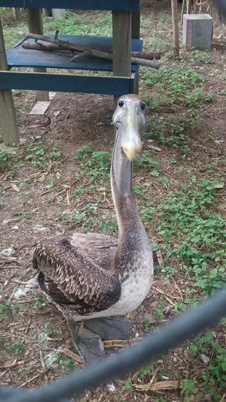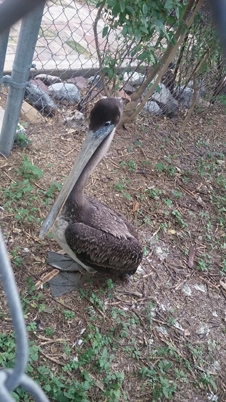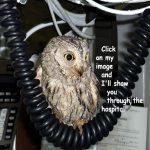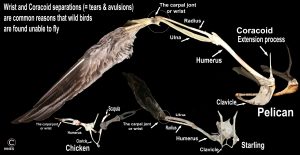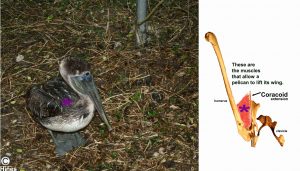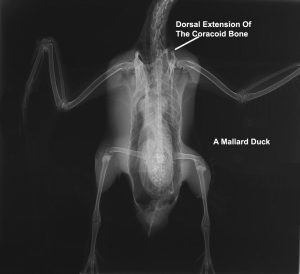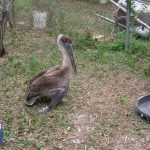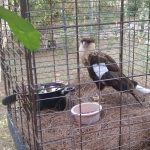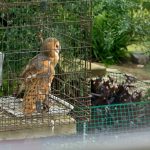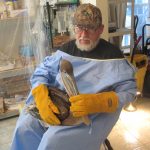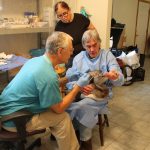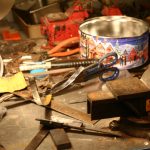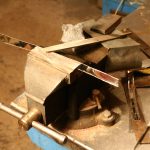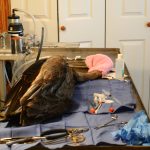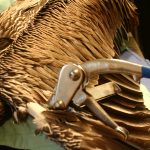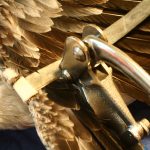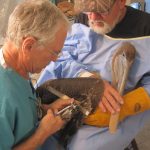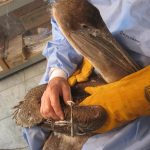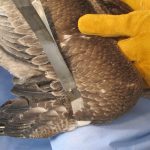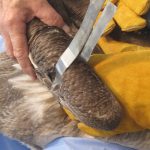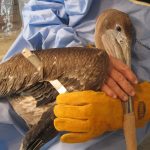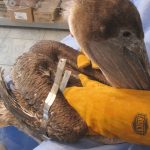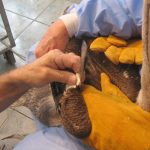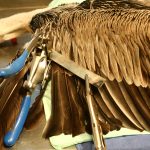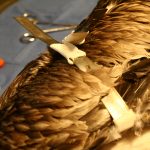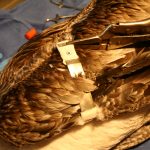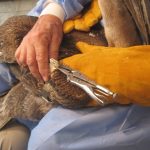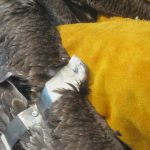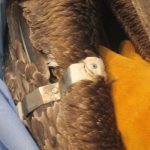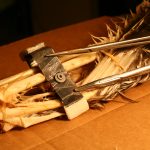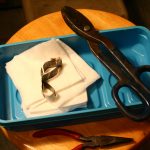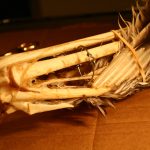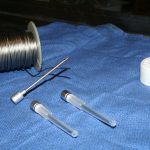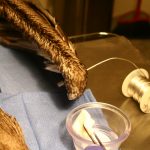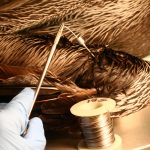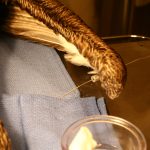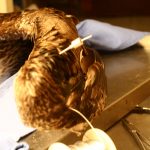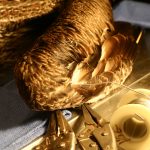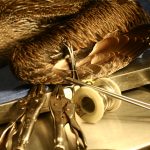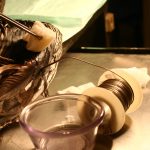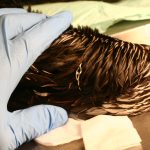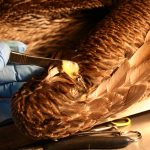Wrist and Coracoid Shoulder Injuries In Birds And Their Repair
Ron Hines DVM PhD
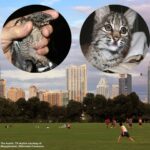 All Of Dr. Hines’ Other Wildlife Rehab Articles
All Of Dr. Hines’ Other Wildlife Rehab Articles
Wing injuries are the most common reason wild adult birds arrive at wildlife rehabilitation centers. Their care can be quite challenging, even disheartening. Every Center makes its own decisions as to whether to attempt to treat them, humanely put them down or perhaps, obtain the permits required to keep them permanently on their premises. Over the many years I have dealt with that issue, I have found that considerably less than a third of the wild birds with wing fractures will regain the flight necessary for them to successfully forage or hunt in the wild. It is perhaps, closer to 10-15% when it comes to birds that naturally feed on the wing – birds like swallows and night jars, raptors and owls, and diving birds such as terns and pelicans.
Well Human Surgeons Who Fix Broken Arms Have Close To 100% Success Rate – So Why Do Wildlife Vets Like You Have Such Poor Success Rates?
It is because of the compromises Nature had to make to allow birds to fly. First, the bones of birds are hollow to reduce their body weight. These wing and leg bones are also exceedingly brittle to give their reduced bone mass stiffness and extra strength. That means that many breaks are “shatter fractures” with multiple, razor-sharp pieces. Much like a glass bottle thrown against a wall. Avian bones are also quite different from mammalian bones in their microscopic structure.
Besides the avian bone’s unique structure, many birds are very small. That makes complex orthopedic surgery very difficult. These thin-walled bones also make the fasteners anchoring orthopedic devices (such as bone screws and pins) difficult or impossible to keep solidly in place.
Their basic urge to fly and natural fearfulness of wild birds make aftercare and rigid stabilization very challenging. If your are told not to move your arm, to keep it in a sling and avoid lifting objects, you are likely to do so. Wild birds are not – and they will disregard the pain they experience in doing so. In Nature, fear is a life-saving trait. But in rehab it works against you.
Subsequent to an accident, birds do not immediately realize that they cannot fly. Their instinct is to get away. In their frantic flapping, they expose the nerves, tendons, blood vessels and ligaments near the fracture site to the sharp edges of their shattered long bones. That often causes non-reparable damage to those essential wing structures. It also commonly leads to sections of the bone now being visible and exposed to the environment. So bacterial and soil contamination of a wing fracture is common.
As healing progresses and new bone forms to bridge the gap after a wing or distal leg fracture, its been my experience that it is not uncommon for the ligaments that pass through the area to be trapped in the new bone (callus). That can limit their return to normal function. While mammals with their sold bones produce an internal callus to reunite the broken bone sections, birds with their hollow long bone structure are limited to producing a larger external callus. That increases their risk that essential ligaments will be trapped in the newly-formed bone bridge.
All those things make successful wing repairs a tough job for a veterinarian. So an overall 15% success rate really isn’t that bad. It isn’t that much different from the success rate that the most experienced equine veterinarians have when a horse breaks its leg at the track. And being a horse or a bird, there is very little tissue (other than skin, nerves, blood vessels and ligaments) surrounding the leg to assist in healing. One must rely upon surrounding muscle and fascia (soft tissue) to supply nutrients for healing and to protect and stabilize the fracture site. Neither birds nor horses have much of that.
Wild birds are athletes. So although we can most always save their lives after a wing injury, it is really hard to return them to the competitive level they need to survive in the wild.
Successful survival following an accident is also species-related. Some birds, corvids in particular, seem more successful in adapting to physical limitations and handicaps that other bird species such as raptors, songbirds and owls. One-eyed, one winged and one legged grackles are likely to confine their locations to sites where food is plentiful – bird feeders, fast food restaurants and dumpsters. Pelicans no longer able to fly spend their time where fishermen clean their catch.
But wing injuries left untreated often drag – eventually fraying feathers and traumatize wingtip tissue. Flocking birds can also be quite unkind to their handicapped flockmates. You usually see the handicaps standing off at a distance. Birds rely on their wings for balance and left untreated, it is common for leg issues to later occur. Those preclude successful foraging in most birds and makes nighttime roosting difficult – opening the way to predation.
Almost all wildlife rehabilitation centers operate on a financial shoestring. They face tough choices as to the allocation of their limited resources. Most find it more worthwhile to tend to the orphaned and the injured that are likely reparable than to dissipate their resources on expensive, time-consuming surgery with uncertain outcomes. Veterinary schools with deep pockets, resources and expertise may agree to do so to disseminate the results. But they never publish the bad ones and they never track the long-term post-surgical survival of those creatures once released back into the wild. I have done those procedures much more successfully in parrots, cage birds and zoo display birds. But none of those critters had to journey into their future relying on their wild feeding success and survival abilities.
Wing Injuries That Lend Themselves To Simple Solutions
These photos are all of actual bones from birds that did not survive their collisions with automobiles
Carpal (Wrist) Injuries
Not all wing injuries involve broken bones. A substantial number (perhaps 15-18%) that come to me either involve torn or over-stretched ligaments of the wrist (carpal joint) or shoulder. A bird’s wrist undergoes similar forces in flying as your elbow does because in flying, there is more force on the feathered surfaces beyond it than before it. If a sudden force, such as a power line or car windshield encounters those distal feathers near their tip, that joint is often injured. Bones that comprise the wrist are rarely broken. Instead, the ligaments that hold the joint together and those that pass over it to extend the wing are stretched, torn or displaced. That causes the wing to droop. Because birds continue to flap the injured wing while in rehab centers, they rarely heal correctly. Traditionally, figure 8 bandages, like this one or the adhesive bandaged caracara in photo #2 below are applied. In pecking birds or swallows, those bandages sometimes work. But birds that can gnaw and tear quickly remove them. In the case of the caracara, he had “chewed” it off in less than 8 hours after he awoke from anesthesia.
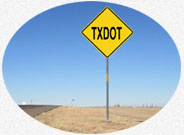
Because of my highway department’s design of the roadway between me and the Texas Gulf Coast, I receive a lot of pelicans with wing injuries during windy times of the year.
Their great wingspan, their preference for port areas with lots of cables and obstructions, and the strong wind gusts often present along the Gulf Coast make them particularly susceptible to wing injuries. The forces exerted on the pelican wrist are immense. Whereas, the secondary flight feathers on an adult brown pelican’s radius and ulna 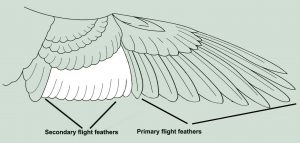 span a distance of about 12 inches; their primary flight feathers from the wrist outward, span a distance of about 19 inches. That places great lateral forces on their wrist. The wrist of a bird should only act as a hinge in one axis maintaining up and down rigidity. When that joint is injured, the wing droops from the wrist outward. Those birds often come in with those outermost feathers soiled and frayed on the damaged side. I have never seen a bird where both wings sustained the same injury.
span a distance of about 12 inches; their primary flight feathers from the wrist outward, span a distance of about 19 inches. That places great lateral forces on their wrist. The wrist of a bird should only act as a hinge in one axis maintaining up and down rigidity. When that joint is injured, the wing droops from the wrist outward. Those birds often come in with those outermost feathers soiled and frayed on the damaged side. I have never seen a bird where both wings sustained the same injury.
The frequency with which I see this problem led me to search for a better way to immobilize their wrist joints long enough for them to heal. I call it a DOT clamp. It is comprised of a light metal band. The pelicans peck at it, but they cannot remove it and during the time they wear it (30-60 days) it supports the wing in its normal position. They loose a few surrounding feathers preening the device. But those small feathers do not affect their ability to fly and they grow back at their next molt.
When placing the clamp wing support, count off the first ten flight feathers and then place it there.
Shoulder And Coracoid Injuries
When the blow the bird received was closer to the body than the wrist, it is often the muscle connections to the fragile coracoid bone extension and shoulder girdle that are torn or detached. Sometimes the bony extension itself is fractured, as in this photo 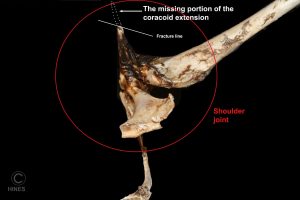
The coracoid bone is a bit of enigma. I know of no detailed studies of how it contributes to wing movement, but in my opinion, its proper function is as an anchor of the muscles that allow a bird to lift its wing. Birds with problems here often droop their shoulder and, of course, they can not fly. I see it most commonly in birds whose wingspans are very long in proportion to the size of their bodies. Enlarge the fourth image from the top of this page or click here. Most anatomical sketches of bird wing structure are based on the chicken. Chickens I have dissected, such as the one in this old textbook image 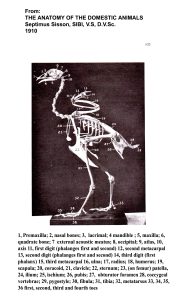 , have a poorly developed (rudimentary) dorsal coracoid process (aka “shoulder extremity of coracoid base”) In ducks, it is a bit more developed , in passerines like starlings, even more so:
, have a poorly developed (rudimentary) dorsal coracoid process (aka “shoulder extremity of coracoid base”) In ducks, it is a bit more developed , in passerines like starlings, even more so:
The DOT clamp is also an excellent way to help immobilize coracoid and other related shoulder injuries to give them a chance to heal.
The device minimizes flapping and lessens the weight an extended wing would place on the bird’s shoulder elements, giving it a better chance to heal. Any number of different elements that make up the bird’s shoulder can be injured.
With either type of injury, when a figure 8 bandage will not stay on, as a salvage procedure, one can clip the primary flight feathers on the injured wing to relieve weight and toque on the wrist and shoulder. Cut them just where the fluff begins and place them in an envelope. You can imp them back once the wrist joint or coracoid has had a few months to heal or keep the birds until those feathers molt. Pulling the feather stems out will induce a new feather to grow; but it also increases the risk of ingrown feathers. The birds will still need long-term confinement. Although birds like nightjars and swallows that will only feed on the wing can be force fed for a time, I find it kinder to put them down.
Below this paragraph are some photos of the device and its application. Click on any of them to enlarge the image. Steel “Tin” food containers are generally constructed of 0.01” steel (ten one thousandth of an inch thick) that has been coated to prevent corrosion. I heat it cherry red to burn of that coating because, I want the device to rust away quickly if water birds should escape while still wearing it. Properly applied, the clamps do not restrict circulation. They rest on the bird’s radius bone and only apply upward force on primary feathers of the distal wing. That force can be increased or decreased any time by simply bending the device with ones fingers.
If you are doing pelicans, feed three times a day. Mature brown pelicans (7-9 lbs) will gladly eat 2 pound of finger mullet and sand trout a day and would gladly consume more. Larger shrimper bi-catch fish are cut into 3-5 inch diagonal slices with poultry shears and the fins and spines removed. Although I keep water bowls at hand, I have never seen them drink from them. Multiple birds need multiple feeding trays. Barrel lids and plastic hot water heater overflow trays work well for that. If not used, the birds will swallow any surrounding trash that clings to the fish. Birds housed on cement are prone to bumblefoot and subsequent foot arthritis.
Photos #27 through #37 are an alternative surgical technique that accomplishes the same thing. It requires anesthesia. The pre-placement of a 12 gauge hypodermic needle allows 18 gauge stainless steel wire to be easily threaded through it and then the needle removed. Like a human body piercing, the tract that the wire follows lines with epithelial cells and has not given infection problems. Some birds, however, will traumatize themselves in an an attempt to remove the wire. Preening is a very basic instinct in birds and anything they perceive as foreign encourages them to attempt to remove it.
A Non-surgical Coracoid Stabilization Technique:
Still have questions ? Email me

